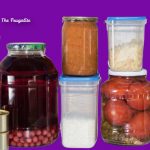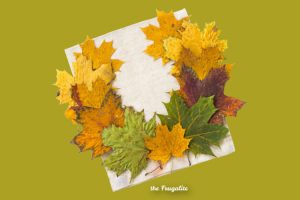(Psst: The FTC wants me to remind you that this website contains affiliate links. That means if you make a purchase from a link you click on, I might receive a small commission. This does not increase the price you’ll pay for that item nor does it decrease the awesomeness of the item. ~ Daisy)
By the author of the FREE online course Growing Self-Sufficiency: The Whole Picture
Last night, I opened my compost container in the kitchen, and dozens of fruit flies made a fast dash for freedom. Was I worried? Heck no! The year before, I would have suffered with the infestation, trying to swat them all, or grudgingly gone to the hardware store to spend some of my hard-earned cash on a trap.
Instead, what did I do last night? I built a fruit fly trap in just a few minutes. That got me thinking….what other things do I make for myself around the homestead that save me money? So, that’s how this article got started, dear Frugalites, and when you get to the end of the article, get ready to share your own DIYs with the Frugalite community. Are you ready?… Get set… Go!
Fruit Fly Trap
Like most homesteaders, I have a lot of canning jars around…a LOT! So, last night, I used a pint jar and a canning lid ring to make my fruit fly trap. In order to do this, you need to have some apple cider vinegar on hand, which I always do. Just pour a couple of tablespoons of apple cider vinegar into the bottom of your jar. If you want to use a half pint, that would work, too.
Cut a small piece of plastic around twice the size of the lid. Many types of plastic would work, like saran wrap. I used a piece of a used and washed sandwich bag. Once the vinegar is in the jar, put the plastic on top. Keep some tension on the plastic while you screw the lid on. You want it to be fairly taut. Then, use a small knife or skewer to pop a few holes in the top. The holes need to be big enough for the fruit flies to get in. If the holes are really TOO big, they may escape. Try it. You will figure it out! Once the holes are done, swirl the enticing vinegar around in the jar. Place the jar in the infested area. In only a day or so, mine has collected more than I can count, and there are no more flies hanging out on top. Total Savings: Around $8.
Salt/Sand Mix
During our long Canadian winters, I have found that sometimes you want salt, and sometimes you want sand. For example, the front steps of my eco-cabin are poured concrete, and even a bit of pure salt will damage them. So, I keep a small bag of sand just inside the door for sprinkling on the step. However, when I’m out on the road, I always have a salt/sand mix in my car.
Ya, I could buy it for around $5. As I have very sandy soil here on my homestead, I benefit from that. I buy bags of premium salt and custom-mix it into five-gallon pails that I keep in my car through the winter. Many, many times, having that mix and some extra bags of sand (shoveled into old feed bags from my land) and salt in my trunk has helped me, or someone else, get unstuck. If I buy the salt for $4.50 and it goes twice as far with my sand mix, I save a fair bit over the course of the winter. Savings: Approximately $11 over one winter, maybe more!
Kefir
If you’re interested in gut health and probiotics, have you tried kefir? Some call it the ultimate probiotic. True kefir is cultured with little grains called Kefira, which look like spongy little cauliflowers. While they sell kefir in stores, most of it is not cultured by the real Kefira grains: it is a fake mix that contains only a fraction of the cultures in true kefira, which can number in the dozens! Learn more about how kefir is a true probiotic and all of its health benefits here.
That’s why I make kefir at home. It is a mainstay of my diet, and I’m convinced it helps keep me healthy. One liter of fake kefir from the store will cost you up to $3.75. That is almost three times as expensive as making your own from whole milk. It takes only a few minutes every other day or so to harvest the kefir and add fresh milk to the colony. If you’d like to learn more about getting started with making your own kefir, including where to source the live grains, check out my How to Guide on my website here: Savings at three homemade litres a week: $7.50. Savings all year: Almost $400!
Bread
 Each week, I make a loaf of Irish Soda Bread for my week. I eat 1/8 of the loaf each morning for breakfast. It is made with half high-quality organic whole wheat flour or my own hand-ground organic spelt and half regular all-purpose flour. As well, it contains… You guessed it… Kefir! The culture in the kefir is crucial for helping this soda bread rise. While bread isn’t that expensive generally where I live, here, going for a couple of bucks a loaf, it can be upwards of $5 in some areas of the US and Canada, and mine does not contain any additives or preservatives.
Each week, I make a loaf of Irish Soda Bread for my week. I eat 1/8 of the loaf each morning for breakfast. It is made with half high-quality organic whole wheat flour or my own hand-ground organic spelt and half regular all-purpose flour. As well, it contains… You guessed it… Kefir! The culture in the kefir is crucial for helping this soda bread rise. While bread isn’t that expensive generally where I live, here, going for a couple of bucks a loaf, it can be upwards of $5 in some areas of the US and Canada, and mine does not contain any additives or preservatives.
I love the dense texture of this bread, which is more like a biscuit, really. I make my bread for pennies a loaf, buying all-purpose flour only when on sale, and making my own kefir. The only other ingredients are baking soda and a bit of salt. If you’d like to try this out for yourself, check out another How to Guide on my website. You’ll have to scroll down…it’s the last one on the list! Savings: Maybe $75 per year.
More Shed Space
OK, I admit I’m a bit of a pack rat. Planning for the apocalypse kind of has that effect on folks. When I ran out of shed space a couple of years ago, I built a “lean-to” style addition on my shed out of leftover construction materials and garbage. I used free skids, setting them up against the wall of my shed. More free skids provided the base. On the far side, I placed two sturdy cupboards I found in a dumpster. They were around three feet high. With wood scraps from my wood pile, I built a frame that ran from the top of the skids set against my shed to the top of the cupboards. This is the “lean-to” roof.
Thank goodness I made sure the doors of the cupboards were facing outside before I screwed on the frame! The roofing metal that I used for my roof came covered with some free protective pieces of metal that were around 5 feet long. These were not as sturdy as my roofing but were plenty sturdy for my lean-to roof. I think I used two of them, so they were probably around 3 feet wide each.
With leftover roofing screws, I completed the job by screwing these pieces of metal into the frame. Voila! A lean-to extension that cost me….well, it cost me… um…nothing but my time over the course of one weekend. However, its value to me is priceless! All of my garden stuff fits in those two sturdy cupboards, there is space to spare under the lean to for hoses, extra buckets, you name it. If you like making good use of garbage, check out this article on some of my great garbage finds.
Do-It-Yourself is Save-Cash-4-Yourself!
If you take an attitude of learning and fun, the sky’s the limit. Could you see yourself trying any of the thrifty DIYs offered here? Do you have one you can share with us? Please tell us in the comments below.
About Colette
Colette is passionate about sharing her knowledge of thrifty living and self-sufficiency. She has developed her skills in self-reliance living in the suburbs, the city, and more recently, on her own Half-Acre Homestead. Colette lived five years completely off-grid and without running water in an eight by 24 foot tiny home while designing and building her own 18 by 24-foot eco-cabin. Her website, Half Acre Homestead is attracting followers from around the world who want to become more self-sufficient. Colette invites you to stop by the Homestead and check out all of the great resources including the practical How To Guides, A Tiny Home Resource Center and her organic gardening stories on her blog. She shares her wholistic model (body/mind/spirit) for achieving self-sufficiency in her Free Course, “Growing Self-Sufficiency: The Whole Picture.” Stop by the Homestead today to register free of charge!











4 thoughts on “5 Things I Make Instead of Buying that Save Me Cash”
I’ve been a long time fan of solar powered gadgetry ,,, some available at retail but some can be DIY’d at home. Here’s an example of the dirt cheapest solar panel cooker that I made for a little under $10 worth of materials from Hobby Lobby a long time ago:
Copenhagen Solar Cooker – Homemade/DIY
per this 5:28 minute video, from RimstarOrg on Jun 21, 2012
https://www.youtube.com/watch?v=H5_z4-ocLUs&t=2s
See more detail in the Description.
Plus a transcript link.
Plus many related YT video links.
Plus 44 comments.
I probably paid more for the two Pyrex glass bowls. The scrap steel rods I used to make the folding trivet (that holds the lower Pyrex bowl about 3 inches above the bottom reflector in order to get more sunlight reflected upwards from below) were salvaged from my junk pile.
There are about five different categories of such solar gadgets. One type made from a Fresnel lens salvaged from a trashed giveaway rear projection TV can be made into a high heat fast cookers … or slowed down if you move your cooking pot enough distance away from the highest heat focal lens point.
Another use for solar energy is to make a DIY solar distiller. The best design I’ve seen looks like a wooden pool table with a slightly slanted glass top (at about a 9° angle). Sharon Buydens taught many families along the US southern border with Mexico how to make these when they could not get local politicians to cooperate for a local clean water supply. Such a distiller will clean out ANY kind of contaminant … including some nasties that even the best water filters can’t remove. Her how-to book on Amazon is titled DIY: How to Build a Solar Water Distiller: Do It Yourself – Make a Solar Still to Purify H20 Without Electricity or Water Pressure
by Sharon Buydens | Sep 4, 2015
That’s why when a neighbor of mine was remodeling his house and had set out some left-over sliding glass doors for trash pickup. I asked him if I could save the trash hauler a trip and bring home those doors … he graciously said yes.
There are multiple videos on Youtube that cover some of the how-to of this concept but the best detail is in her book.
Depending on your latitude there is more or less sunlight available on a year-around basis. It’s easy to run an online search for the amount of sunlight available at the largest city close to where you live. That might give you a rough idea of how much you might possibly save on other power or fuel bills that you’d have to pay.
–Lewis
Hi Lewis, I have bookmarked the link that you shared. Thank you very much! When things settle down a bit here (and I genuinely hope that they will soon!), exploring this idea is high on my list. I love that you have a junk pile! I have very fond memories of my grandfather’s junk pile on the family farm. I used to play in it when I was a child. To me, it was full of treasures. Thank you for consistently sharing helpful ideas with the Frugalite community. We are all benefitting from your experience and frugal know-how. Much appreciated.
I make three loaves of bread at a time . Then I slice all three and freeze two of them. The third lasts me roughly a week, but I can always thaw another if I run short. It is easy to slice them all at once and slicing a frozen loaf would be very difficult. I keep a bakery loaf in the freezer in case I don’t have time to make any before I run out. I can just grab enough slices to carry me over.
Hi Mary, What a fantastic system you have! By making sure that you don’t run out, you are able to keep baking (and therefore saving!). All these tips really do add up to savings. Much appreciated.